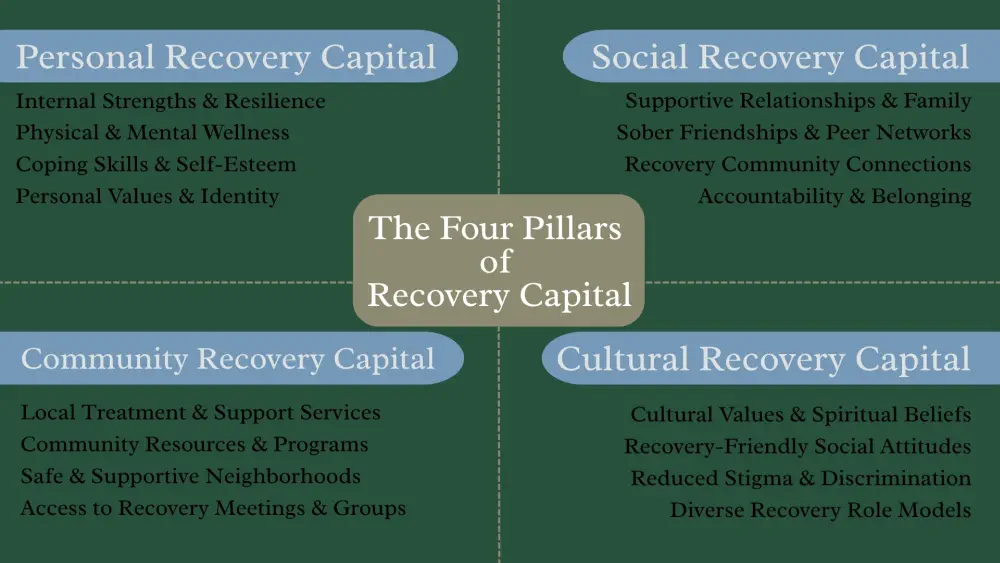We offer medical detox and multiple addiction treatment options in our
luxury treatment centres in Port Hope, Cobourg, and Ottawa.
What is Recovery Capital?
Quitting substances takes more than sheer determination. You need resources. Support systems. Skills you can draw on when cravings hit at 2 AM. A stable place to sleep. People who answer your calls.
Recovery capital represents all these combined—what's inside you and what surrounds you. Your collection of tools, relationships, and advantages that help you start recovery and keep going when things get tough.
Treatment centres across Canada now recognize a crucial fact: detox solves only part of the problem. Lasting recovery requires building the foundation that keeps someone stable long after formal treatment ends. Recognizing and strengthening your recovery capital becomes essential to success.

Key Takeaways:
- Recovery capital started as research - Two researchers discovered why some people succeed without treatment while others relapse after expensive programs. The difference wasn't willpower.
- Four distinct types exist - Personal, social, community, and cultural capital. Each plays a unique role. Your strengths in one area can't always compensate for gaps in another.
- You can actively build it - Specific strategies strengthen each type of capital, from repairing relationships to securing stable housing to connecting with your cultural identity.
- Measurement tools provide clarity - Standardized assessments like the BARC-10 and ARC reveal exactly where you're strong and where you need support, eliminating guesswork in treatment planning.
- Professional programs accelerate growth - Treatment centres that assess and actively build recovery capital help level the playing field, giving everyone better chances regardless of their starting point.
What Made Scientists Rethink Addiction Treatment?
Two researchers, William Cloud and Robert Granfield, noticed something puzzling in the late 1990s. Some people overcame severe addictions without ever entering treatment. Others completed expensive programs but relapsed within weeks.
The difference wasn't willpower. People with strong support networks, stable housing, and job skills succeeded more often—regardless of treatment. Cloud and Granfield published their findings in 1999, coining the term recovery capital to describe this collection of addiction recovery resources.
Before this research, addiction treatment focused almost entirely on what was wrong. Diagnose the problem. Eliminate the substance. Fix the broken person. This deficit model worked for some folks, but left many others struggling.
Recovery capital flipped the script. Instead of asking "what's wrong with you," treatment providers started asking "what strengths can we build on?" This shift changed how facilities design programs and measure success.
William White expanded these ideas throughout the 2000s. His work showed that therapeutic processes need to reach beyond clinical walls. Strategies targeting family and community recovery capital can elevate long-term recovery outcomes, creating sustainable change that medical interventions alone often miss.
These insights led researchers to categorize the various resources that support recovery, creating a framework that professionals now use worldwide.
The Four Pillars of Recovery Capital

Recovery capital breaks down into four interconnected categories. Each plays a distinct role, and all work together to support your path forward.
Personal Recovery Capital
Your personal recovery capital includes everything you carry within yourself. Physical health weighs heavily here. Someone with untreated chronic pain or serious medical conditions faces steeper challenges than someone in good health. Your body's condition affects your energy for recovery work.
Mental and emotional wellness form another crucial piece. Depression, anxiety, trauma—these create real barriers that need addressing. Self-esteem influences whether you believe recovery is even possible for you. Hope provides the fuel to keep trying when setbacks happen.
Skills and knowledge count too. Can you manage stress without substances? Do you know how to ask for help? Have you learned to recognize your triggers? Education level, employment history, and financial resources all contribute to this category.
Consider two people entering treatment on the same day. One holds a college degree, has savings, and has developed coping strategies through therapy. The other dropped out of high school, is homeless, and has never learned healthy stress management. They both deserve excellent care, but their recovery capital differs dramatically—requiring different levels and types of support.
Social Recovery Capital
Social recovery capital involves intimate, familial, and social relationships that support recovery. These connections either strengthen or undermine your efforts daily.
Your intimate partner's attitude carries significant weight. Do they encourage sobriety or pressure you to use? Family members might help or hinder, depending on whether they view addiction as a medical condition or a moral failing.
Friendships require evaluation, too. Friends who respect your recovery and participate in sober activities build your capital. Those who tempt you toward old patterns drain it quickly. Many people need to completely rebuild their social circles during the recovery process.
Community connections provide stability beyond close relationships. Workplace ties, membership in organizations, participation in faith communities—these create structure and accountability. They provide a place to belong that doesn't revolve around substances.
The willingness of your network to actively participate in your recovery determines how much social capital you actually have. A large family that refuses to acknowledge your problem offers less support than a small circle of friends who show up consistently.
Community Recovery Capital
Community capital encompasses a community's willingness to be sympathetic to those struggling with addiction, along with concrete resources available locally.
Treatment availability varies wildly across Canada. Urban centres offer numerous options, while rural areas might have one facility hours away. Transportation access becomes critical when you need regular therapy appointments.
Housing stability and safety create the foundation for recovery work. Trying to stay sober while living in a place where everyone uses substances is nearly impossible. Affordable, stable housing in a recovery-supportive environment significantly boosts success rates.
Local attitudes toward addiction shape your experience profoundly. Communities that view recovery as possible and celebrate people getting help reduce stigma. Those who treat addiction purely as a character flaw make seeking help much harder psychologically.
Employment opportunities, education programs, and healthcare access all factor into community recovery capital. Some areas provide abundant resources, while others leave people with few options beyond expensive private treatment.
Cultural Recovery Capital
Cultural capital represents the values, beliefs, and practices within your cultural background that can support recovery. This dimension is often overlooked but carries significant power.
Religious and spiritual traditions frequently offer frameworks for healing. Some people find tremendous support through faith communities that emphasize forgiveness, redemption, and service to others. Cultural practices like meditation, ceremony, or communal celebration can provide alternatives to substance use.
Cultural recovery capital includes societal attitudes toward addiction treatment and the stigma associated with addiction. Indigenous communities in Canada often integrate traditional healing practices alongside modern treatment, creating culturally relevant pathways to recovery.
Your cultural identity influences which recovery approaches feel authentic. AA works beautifully for some people but feels completely wrong for others based on cultural fit. Recovery support that resonates with your background strengthens this form of capital.
Visible role models from your cultural community who achieved long-term recovery demonstrate that success is possible for someone like you. Representation proves crucial when you're fighting to rebuild your life.
Knowing the categories helps, but action creates change. Each type of capital needs specific attention and deliberate effort.
How to Build Recovery Capital in Addiction
Boosting Personal Capital
Physical health improvements begin with the basics. Regular sleep schedules, nutritious meals, and medical care for chronic conditions all contribute. Exercise rebuilds strength and produces natural mood improvements.
Mental health work often requires professional help. Therapy teaches emotional regulation skills and processes underlying trauma. Learning about your triggers and developing specific coping strategies gives you tools for difficult moments.
Education and skill development create future opportunities. Some people return to school during recovery. Others learn trades or pursue certifications. Building marketable skills increases confidence and employment options.
Strengthening Social Capital
Relationship repair takes time and consistency. Family therapy can heal damaged connections, but some relationships may need distance if they threaten your recovery. That's a painful but sometimes necessary choice.
Building new sober friendships requires going where people in recovery gather. Support groups, recovery community organizations, sober recreational activities—these spaces let you meet others walking similar paths. Quality outweighs quantity here.
Peer support provides unique value. Someone who's been through addiction understands struggles in ways others simply can't. Developing relationships with people further along in recovery gives you mentors and hope.

Developing Community Capital
Stable housing should be a priority. Recovery residences provide structured environments specifically designed to support sobriety. For others, securing an apartment away from old, using locations makes a crucial difference.
Connecting with local resources takes research but pays off. Treatment centres often maintain lists of community supports. Recovery coaches help navigate available services and advocate for needed resources.
Employment rebuilds purpose and financial stability. Some people need to start with volunteer work or part-time positions while building consistency. Others can return to previous careers. The key is finding something that provides structure without overwhelming you.
Cultivating Cultural Capital
Explore recovery pathways that align with your cultural background. If faith matters to you, consider seeking out religiously based recovery supports. If traditional practices hold meaning, find programs that incorporate them.
Connect with others who share your cultural identity and are in recovery. Their experiences managing treatment while maintaining cultural values can guide your own path. You don't have to choose between culture and recovery—they can strengthen each other.
How to Measure Recovery Capital

Several standardized tools now exist for assessing recovery capital, each offering different benefits depending on your needs.
The Assessment of Recovery Capital (ARC) is a 50-item scale measuring recovery strengths across 10 domains. It covers substance use patterns, psychological and physical health, community involvement, social support, meaningful activities, housing, risk-taking behaviours, coping skills, and recovery experience. The depth of information makes it valuable for treatment planning.
The Brief Assessment of Recovery Capital (BARC-10) condenses the ARC into 10 questions, making it practical for busy clinical settings. The briefer version enhances the measure's utility while maintaining accuracy. Treatment centres can administer it quickly during intake and repeat it regularly to track progress.
The Multidimensional Inventory of Recovery Capital (MIRC) measures four types of recovery capital—social, physical, human, and cultural—assessing both positive and negative forms within each category. This tool specifically captures barriers alongside resources, giving a complete picture of what helps and what hinders recovery.
The R1 Recovery Capital Screener (RCS-36) creates actionable recovery plans alongside measurement. Organizations can use it to guide case management and demonstrate program effectiveness.
Why bother with assessment tools for recovery capital? Results show treatment teams exactly where you have strengths to leverage and gaps requiring additional support. Someone scoring high on personal capital but low on social capital needs different interventions than someone with the opposite profile.
Measurement also tracks changes over time. Seeing your scores improve provides concrete evidence that recovery efforts are working. When scores drop, it signals the need for increased support before a full relapse occurs.
What Approach Does CCFA Use for Recovery Capital?
At the Canadian Centre for Addictions, we've structured our programs around strengthening all forms of recovery capital. Treatment begins with assessment, identifying your current resources and the areas needing development.
Our facilities in Port Hope and Cobourg provide environments specifically designed to build community capital during your stay. Small group settings allow personalized attention. Natural surroundings reduce stress. Quality nutrition and exercise programs rebuild physical health, which is a key component of personal capital.
Individual counselling addresses emotional wounds and teaches practical coping skills. You'll work on identifying triggers, managing cravings, and handling difficult emotions without substances. These sessions also explore underlying mental health conditions requiring treatment.
Family involvement remains central to our approach. We offer family therapy to repair damaged relationships and educate loved ones about addiction as a medical condition. When families understand recovery as a process requiring ongoing support, they become part of your social capital rather than obstacles.
Group therapy connects you with peers facing similar challenges. These relationships often continue long after leaving our facility, becoming part of your lasting support network. Learning that others truly understand your struggles reduces isolation.
We help clients connect with community resources before discharge. Need stable housing? We'll help locate recovery residences or supportive housing options. Require ongoing therapy? We'll facilitate connections with local providers. Employment assistance, educational resources, and continued medical care—we ensure these pieces are arranged.
Our approach recognizes that building strong recovery capital in addiction takes time. Change doesn't happen in 30 days. That's why we emphasize aftercare planning and ongoing support. Recovery is a process, not an event.
FAQ
What exactly does recovery capital mean?
Recovery capital refers to all the internal and external resources you can use to start and maintain recovery from substance use. This includes personal strengths like coping skills and good health, social support from family and friends, community resources like treatment access and housing, and cultural factors like faith traditions that support healing.
How is recovery capital different from just getting sober?
Sobriety focuses narrowly on stopping substance use. Recovery capital takes a broader view, recognizing that sustained recovery requires addressing multiple life areas, including physical and mental health, relationships, housing, employment, community connections, and cultural identity. Building these resources makes staying sober much more achievable.
Can someone with low recovery capital still achieve lasting recovery?
Yes, absolutely. People start from very different places. Those with limited recovery capital typically need more intensive treatment and extended support services. Professional programs can help build the resources you're lacking. Recovery is possible for everyone, although the path may vary depending on your starting point.
How long does it take to build recovery capital?
There's no fixed timeline. Some aspects improve quickly—you might rebuild relationships or secure stable housing within months. Other areas take longer—processing trauma, completing education, or fully healing physical health can require years. The key is consistent forward movement rather than speed. Recovery capital grows progressively as you invest in different areas of your life.
Do I need to score high on all types of recovery capital?
Not necessarily. People recover successfully with varying strengths and weaknesses across different capital types. The goal is to identify where you're strong and leverage those resources while working to improve weaker areas. Someone with excellent social support but limited education might focus on skill-building while their network provides stability. Assessment helps create this personalized approach.
How do Canadian treatment centres measure recovery capital?
Many facilities use standardized assessment tools like the BARC-10 or ARC scales during intake. These questionnaires ask about various life areas—housing, employment, relationships, health, and coping skills—to create a baseline. Regular reassessment throughout treatment tracks progress. The Canadian Centre for Addictions incorporates recovery capital measurement into all treatment planning, ensuring support matches your specific needs and circumstances.
Article sources
- Cloud, W., & Granfield, R. (1999). "Coming Clean: Overcoming Addiction Without Treatment." New York University Press. Available at: https://nyupress.org/9780814731604/coming-clean/
- Granfield, R., & Cloud, W. (2001). "Social context and 'natural recovery': The role of social capital in the resolution of drug-associated problems." Substance Use & Misuse, 36(11), 1543-1570. Available at: https://pubmed.ncbi.nlm.nih.gov/11693955/
- White, W., & Cloud, W. (2008). "Recovery capital: A primer for addiction professionals." Counselor, 9(5), 22-27. Available at:https://www.naadac.org/assets/2416/whitewlcloudw2008_recovery_capital_a_primer.pdf
- Groshkova, T., Best, D., & White, W. (2013). "The Assessment of Recovery Capital: Properties and psychometrics of a measure of addiction recovery strengths." Drug and Alcohol Review, 32(2), 187-194. Available at: https://pubmed.ncbi.nlm.nih.gov/22882622/
- Vilsaint, C.L., et al. (2017). "Development and validation of a Brief Assessment of Recovery Capital (BARC-10) for alcohol and drug use disorder." Drug and Alcohol Dependence, 177, 71-76. Available at: https://pubmed.ncbi.nlm.nih.gov/28578224/
- Best, D., et al. (2016). "Recovery capital and social networks among people in treatment and among those in recovery in York, England." Alcoholism Treatment Quarterly, 34(3), 293-313. Available at: https://www.tandfonline.com/doi/abs/10.1080/07347324.2016.1182815
- Bowen, E.A., et al. (2022). "Qualitative insights in item development for a comprehensive and inclusive measure of recovery capital." Addiction Research & Theory, 30(6), 403-413. Available at: https://pubmed.ncbi.nlm.nih.gov/36721868/
- Hennessy, E.A. (2017). "Recovery capital: A systematic review of the literature." Addiction Research & Theory, 25(5), 349-360. Available at: https://www.tandfonline.com/doi/full/10.1080/16066359.2017.1297990
- Cano, I., et al. (2017). "Recovery capital pathways: Modelling the components of recovery wellbeing." Drug and Alcohol Dependence, 181, 11-19. Available at: https://pubmed.ncbi.nlm.nih.gov/28950196/
- Laudet, A.B., & White, W.L. (2008). "Recovery capital as prospective predictor of sustained recovery, life satisfaction, and stress among former poly-substance users." Substance Use & Misuse, 43(1), 27-54. Available at: https://pubmed.ncbi.nlm.nih.gov/18189204/





